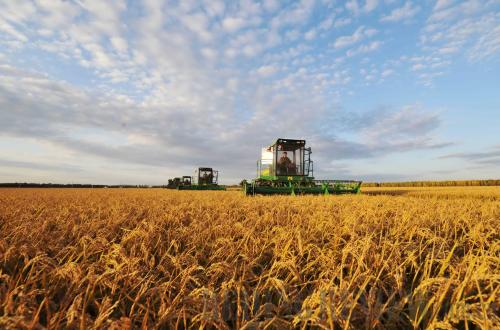|
 |
|
SEEKING FOR MORE GRAIN: Harvesting machines work on a farm in Heilongjiang Province (WANG JIANWEI) |
China is up to its neck in a bumper harvest once again. According to figures from the Ministry of Agriculture (MOA), China's summer grain output reached 129.95 billion kg this year, up 35.5 billion kg year on year. This is the ninth consecutive year that China has reaped such a bountiful harvest.
A bumper harvest this fall seems all but assured, and China's grain output in the whole year will continue growing.
China has always emphasized the need for grain security. During the process of urbanization and industrialization, the Central Government, with the aim of ensuring grain supplies, has stipulated that China must ensure the minimum cultivated land area of 120 million hectares and adopted increasingly strict approval of land use for industrial and commercial purposes. In the meantime, benefiting from progresses in agricultural science and technology, grain output per hectare has kept increasing.
However, as China's grain consumption increases, the self-sufficient rate is decreasing. The target of grain self-sufficient rate set by the MOA is 95 percent. In 2008, the rate already reached 95 percent and in 2010 it fell to 90.6 percent. According to figures released by the General Administration of Customs (GAC) on July 23, in the first half of this year, China imported 40.85 million tons of grain, a year-on-year increase of 41.2 percent, indicating that China's self-sufficient rate of grain is further decreasing this year.
Even amid this ample harvest, China still needs to take preventive measures to cope with the influence from the international market and ensure long-term grain security.
U.S. takes a hit
In the first half of 2012, two thirds of the U.S. crop planting areas were destroyed by the most serious drought in the past 50 years. Affected by the drought, futures prices of corn, soybean and wheat have increased by 30-50 percent since June. The hikes are expected to continue.
This has affected China's grain imports on the other side of the Pacific. Respectively, 4 percent of China's corn supply and 82 percent of soybean supply are satisfied by imports, and the United States is the biggest source of corn and soybean imports for China.
"Soaring grain prices and short supplies in the international market will influence the domestic grain market," said Li Guoxiang, Deputy Director of the Rural Development Institute of the Chinese Academy of Social Sciences (CASS).
| 